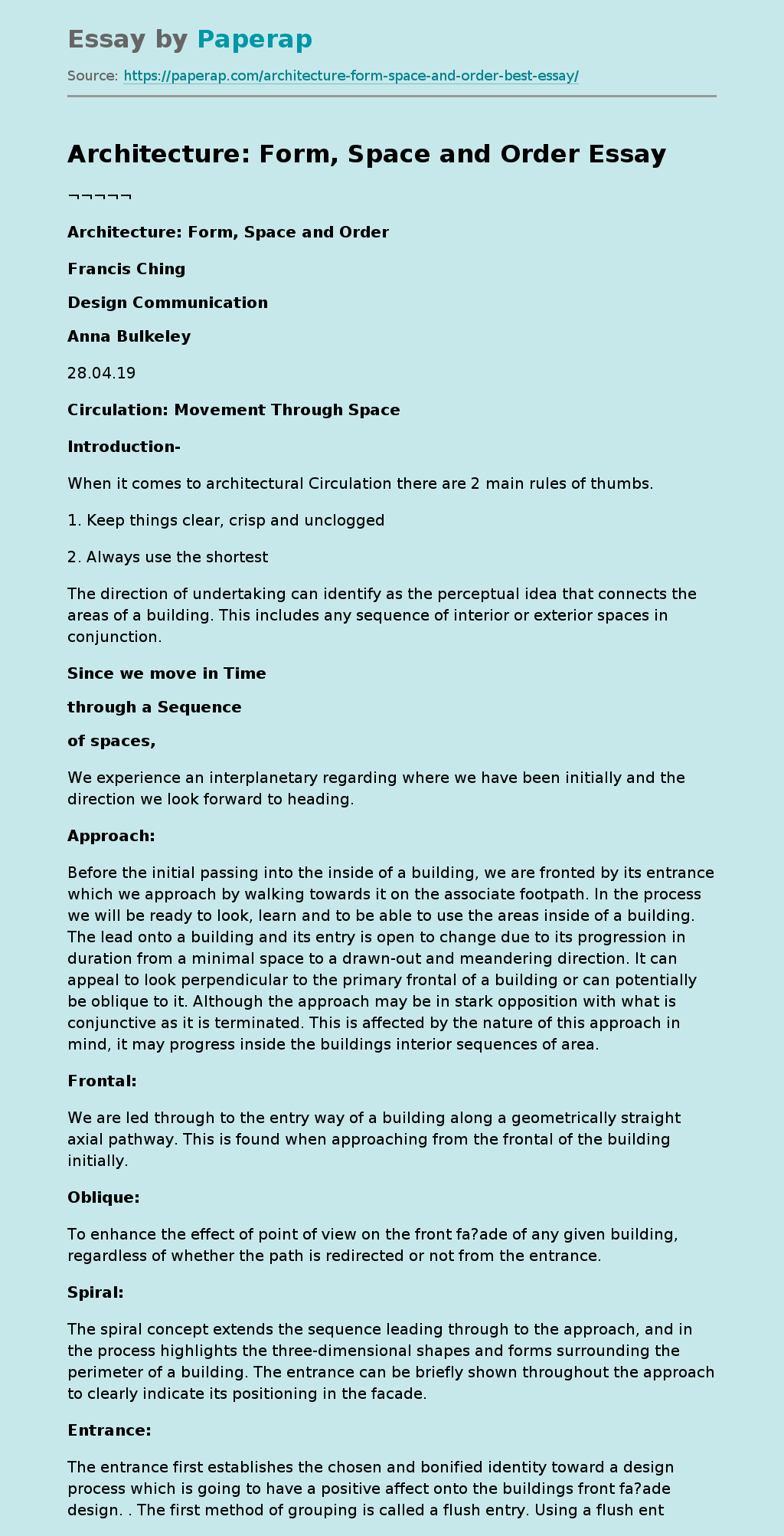Architecture: Form, Space and Order
¬¬¬¬¬
Architecture: Form, Space and Order
Francis Ching
Design Communication
Anna Bulkeley
28.04.19
Circulation: Movement Through Space
Introduction-
When it comes to architectural Circulation there are 2 main rules of thumbs.
1. Keep things clear, crisp and unclogged
2. Always use the shortest
The direction of undertaking can identify as the perceptual idea that connects the areas of a building. This includes any sequence of interior or exterior spaces in conjunction.
Since we move in Time
through a Sequence
of spaces,
We experience an interplanetary regarding where we have been initially and the direction we look forward to heading.
Approach:
Before the initial passing into the inside of a building, we are fronted by its entrance which we approach by walking towards it on the associate footpath. In the process we will be ready to look, learn and to be able to use the areas inside of a building. The lead onto a building and its entry is open to change due to its progression in duration from a minimal space to a drawn-out and meandering direction.
It can appeal to look perpendicular to the primary frontal of a building or can potentially be oblique to it. Although the approach may be in stark opposition with what is conjunctive as it is terminated. This is affected by the nature of this approach in mind, it may progress inside the buildings interior sequences of area.
Frontal:
We are led through to the entry way of a building along a geometrically straight axial pathway. This is found when approaching from the frontal of the building initially.
Oblique:
To enhance the effect of point of view on the front fa?ade of any given building, regardless of whether the path is redirected or not from the entrance.
Spiral:
The spiral concept extends the sequence leading through to the approach, and in the process highlights the three-dimensional shapes and forms surrounding the perimeter of a building. The entrance can be briefly shown throughout the approach to clearly indicate its positioning in the facade.
Entrance:
The entrance first establishes the chosen and bonified identity toward a design process which is going to have a positive affect onto the buildings front fa?ade design. . The first method of grouping is called a flush entry. Using a flush entry allows the building to establish maintained continuity to the surface wall. An upside in using a projected entrance is that it provides sheltering, unlike a flush entry. The third variation is by designing the entrance is was way which is receding. A portion of the exterior area within the building will become received.
Configuration of Path:
Types of Configurations:
1. Linear
2. Radial
3. Spiral
4. Grid
5. Network
6. Composite
Path-Space Relationships:
Paths can have relation their corresponding space, the integrity of this space must be constant. Flexibility is essential in relation to its configuration and to how it links to spaces collectively. Mediating spaces may be used.
Form of the Circulation:
The amount of movement in a building is dependent on the space provided and is a huge presence in terms of volume within the building. Articulated scale and proportion along with light and view are necessities.
Terminated in Space:
Three types of Circulation Spaces:
1. Enclosed
2. One side Open
3. Two sides Open
The type and amount of movement a circulation space can handle must have proportionate width and height. The slope of the stairs should be proportionate to our bodily movements.
Runs of Staircase Configurations:
1. Straight run stair
2. L-shaped stair
3. U-shaped stair
4. Circular stair
5. Spiral stair
6. Geometric stair
Landings which are visible on approach invite ascends the same as trends do at the bottom of a staircase. Stairs are three dimensional forms so its vital its not thought of as a sculpture with exploits the functionality entirely.
D1 Building Code:
In D1- Access routes the objective is to create a safeguard to prevent injury to people in movement process when moving in and out safely and efficiently out of buildings regardless of physical level. To easily moving in and out of buildings and path approaches safely.
Conclusion:
When it comes to circulation in the context of architecture, it is a broader discussion to what initially comes to mind. Circulation in relation to architecture shows the connection between the human and their bodily movements and how the context of the building positively affects this, within a safe manner.
Architecture: Form, Space and Order. (2019, Nov 24). Retrieved from https://paperap.com/architecture-form-space-and-order-best-essay/

